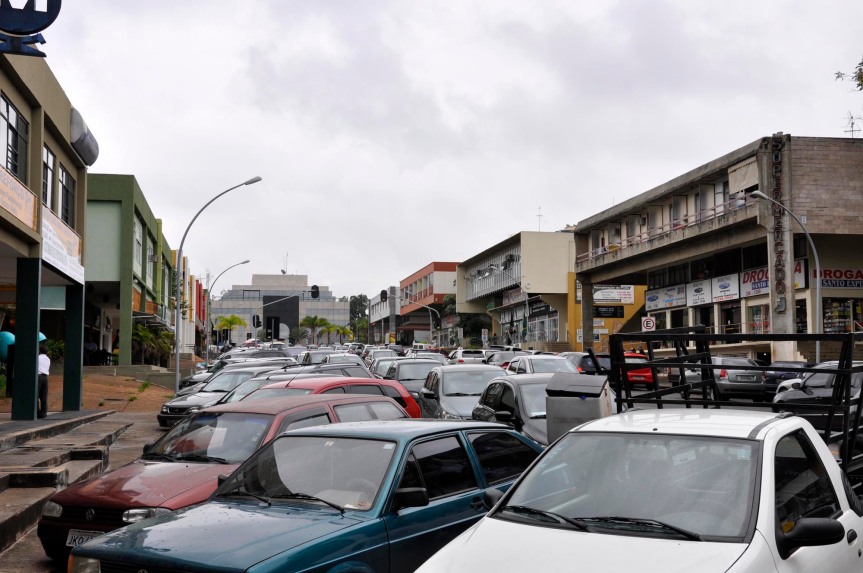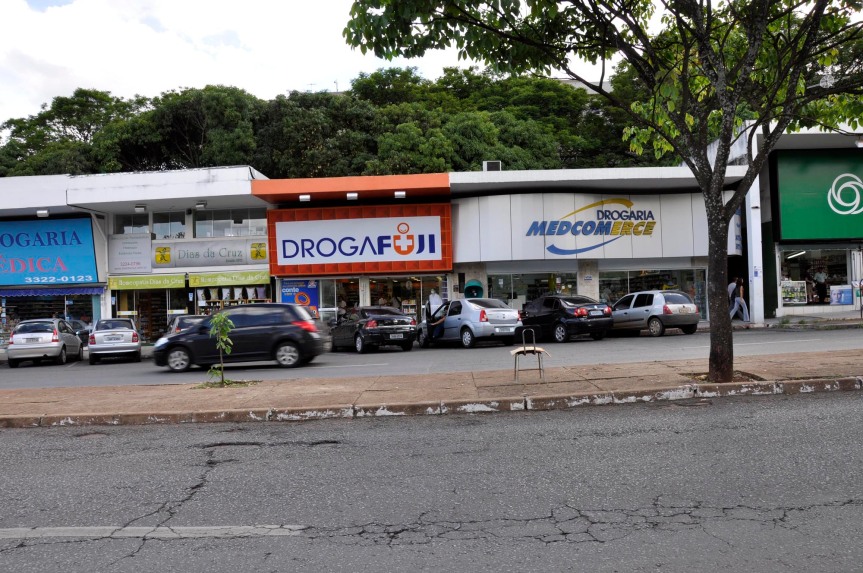Along one side of each superquadra in Brasilia sits a commercial strip designed for everyday shops that would supply the residents of the area. Mirrored in the plan, the commercial edges of neighboring quadra meet to form a commerce street. These streets are offset in every group of four adjoining sectors so that there is no grid formed, but instead alternating isolated strips end in a large grocery store or a cultural or religious institution.
The strip architecture is made of (almost) 2 story concrete frame buildings that step down with the (artificial) terrain. Storefronts sit back from the street behind a twelve foot walkway, which is covered by a fully or partially cantilevered concrete projection from the second story that wraps the entire building. At two or three intervals along the strip the buildings open, creating a covered gap that allows people to walk through into the quadra. The ground floor storefronts open with glass facades while the second story, intended as offices but mostly used as apartments, contain fewer windows and an occasional balcony. These buildings were meant to face their superquadra while the street was meant for loading etc. However before the city was built that decision was reversed, and the commercial buildings all face the street.
As is the case in a city, the commercial strips did not remain equal. Some, located near edges, specialized so that only a particular product can be found. Near the hospital sector at the center of town the last superquadra commercial strip became a drugstore row, where hospital patients can easily pick up their prescriptions. Similarly, there are strips for lighting needs, mechanical needs, and fabrics, to name a few. Along with the specialization in material goods, some strips have become popular for their social scene…the right clubs, pubs and restaurants bring crowds at night.
The architecture of the strips has changed as well, in a process that went hand in hand with their specialization. Because the preservation plan and the building code specify the building perimeter and location in the lot, space allotted to a built structure is extremely valuable and not wasted. The most common changes to the buildings are shed-like additions to the rear of the building, on the quadra side. They are made from a variety of materials ranging from the cheapest corrugated galvanized iron sheets to brick and concrete. This kind of addition occurs in stores, but restaurants gather the space not to enclose it, but to create open seating. Some use the sidewalks, some use the gaps, and a growing number use the space behind as a sort of garden seating, which has begun to clean up some of the disheveled sheds. The more eating/drinking oriented, the more porous buildings remain, but the more divided the space around the plinth and on the sidewalk becomes…partitioned by fake bushes and trees, awnings and oversized signage.

The architectural changes affect the composition of the block and the street. Divisions of the sidewalks separate thoroughfare from stopping place. The type of addition on the rear either reinforces or negates the connection to residential buildings…the more restaurants and social venues a place has the more connected and less forbidding the back of the strip becomes. In the near future this dead zone may become an active connection in some superquadra, its green space inhabited by seating and extremely localized commerce (I already saw an entrepreneurial locksmith booth behind the strip in SQS 103). But the dispersed structure of Brasilia’s superquadra has prevented any further links…these remain islands of activity.
The commerce islands float between the city’s fiercely fast thoroughfares, ultimately isolated pieces of a residentially dominated urban fabric. Here it seems that the articulation of the plan, particularly with regard to roads, is so strong that the architectural changes only operate within the confines of their specified envelope, or slightly beyond. Specialization of commerce types shows a hair more muscle through its movement of commerce or nightlife centers around the pilot plan. But these movements are dwarfed by the effect of the “shopping” metro stop, which holds Brasilia’s largest mall and draws the biggest crowds. The one commercial line running through the city could be another commercial gathering point (or string in this case) does surprisingly little…the W3 carries mostly small scale commerce that isn’t doing so well, even with the presence of the majority of the pilot plan’s buses.

Some new configurations alter the pilot plan, but in light of the highly restrictive codes and the much stronger influence of the growing satellites and their corresponding commerce, the architectural endeavors have a definitive yet small role to play in Brasilia’s aging and growth.












Great article.
Your article offers established beneficial to me personally.
It’s very helpful and you really are clearly extremely experienced of this
type. You have opened my eye to numerous thoughts about this
subject matter along with intriguing, notable and solid articles.